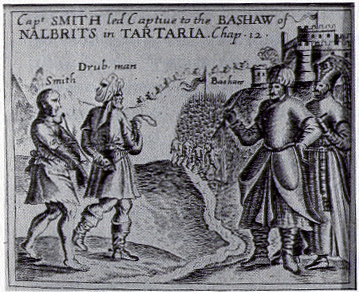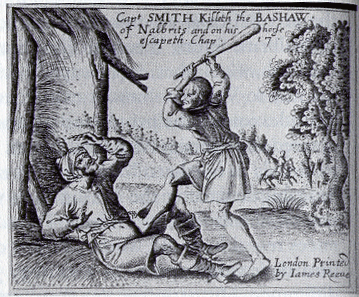
John Smith led into captivity to the Bashaw of Nalbrits by a “Drub-man†(interpreter). From The True Travels, Adventures, and Observations of Captaine John Smith, in Europe, Asia, Affrica, and America, from Anno Domino 1593 to 1629. London, 1630.
by Timothy Marr
Islam has figured in the fashioning of North American cultural definitions since as far back as the first years of European settlement. Inaugurating instances in colonial British America can be seen through brief biographical sketches of the Virginian leader John Smith and the Quaker preacher Mary Fisher.…
John Smith gained experience and credentials fighting Turks in Ottoman Europe well before he ventured across the Atlantic and he prided himself as a hearty crusader against the Muslims. After successfully launching incendiary devices against the Turkish armies in Hungary, for example, he reveled that “the lamentable noise of the miserable slaughtered Turkes was most wonderfull to heare.â€

Smith makes his escape by bashing the Bashaw to death with a club.
The True Travels, one of the first secular autobiographies published in the West, describes how Smith vanquished three Turkish warriors during combative dueling in Wallachia in 1602, a feat for which he was granted a coat of arms portraying three Turks’ heads. Smith afterwards became “a prey to the cruel devouring Turke†and was sold into slavery to a genteel Muslim woman. She became enamored with Smith and sent the twenty-two-year-old infidel to her brother in Tartary to learn the arts befitting a gentleman. Intolerant of his thralldom to this Bashaw of Nalbrits, Smith “beat out [his] braines with his threshing bat,†assumed the Bashaw’s clothes, and escaped back to Christendom, eventually making his way to Virginia. Smith’s experience in the Islamic orient prefigured his attitudes toward the people and places of America and foreshadowed his celebrated experiences with Pocahontas. When Smith anchored in 1614 off the peninsula in northern Massachusetts now known as Cape Ann, he named it Tragabigzanda after the Muslim lady who saved him and called three other coastal islands there the Three Turks. His distinctive cross-cultural experiences reveal how old world patterns of disdaining “others†were imported into new world spaces as a strategy to situate the strangeness of cultural difference. His narrative also demonstrates how control over the “infidel,†often through violence, was constitutive of both Christian identity and noble masculinity. Smith’s coat of arms, whose shield depicts the turbaned heads of the three Turks, appears in the corner of one of the earliest maps of “ould Virginia,†which has the scrolled motto “Vincere est Vivere_ – â€To conquer is to live.â€
Excerpt from Timothy Marr, The Cultural Roots of American Islamicism. Cambridge: Cambridge University Press, 2006, pp. 2-4.